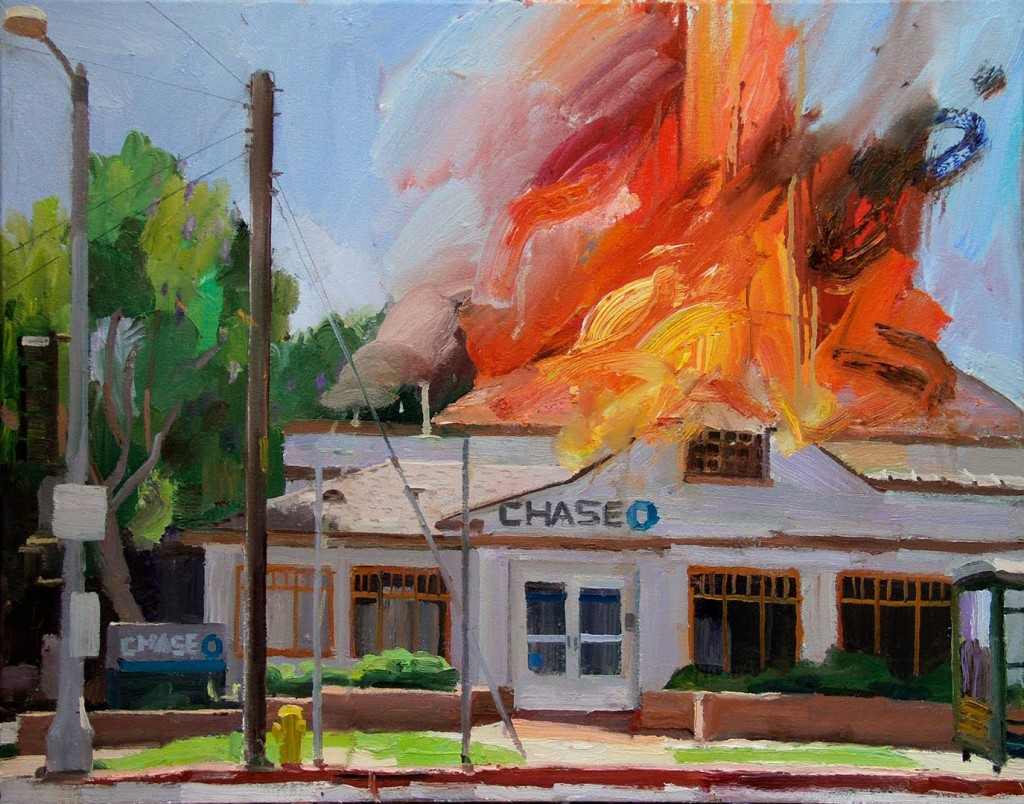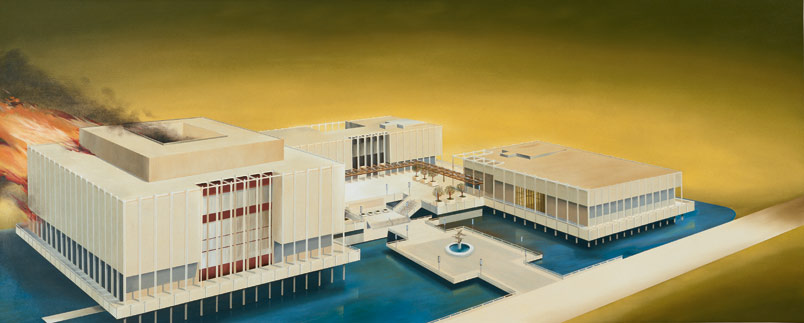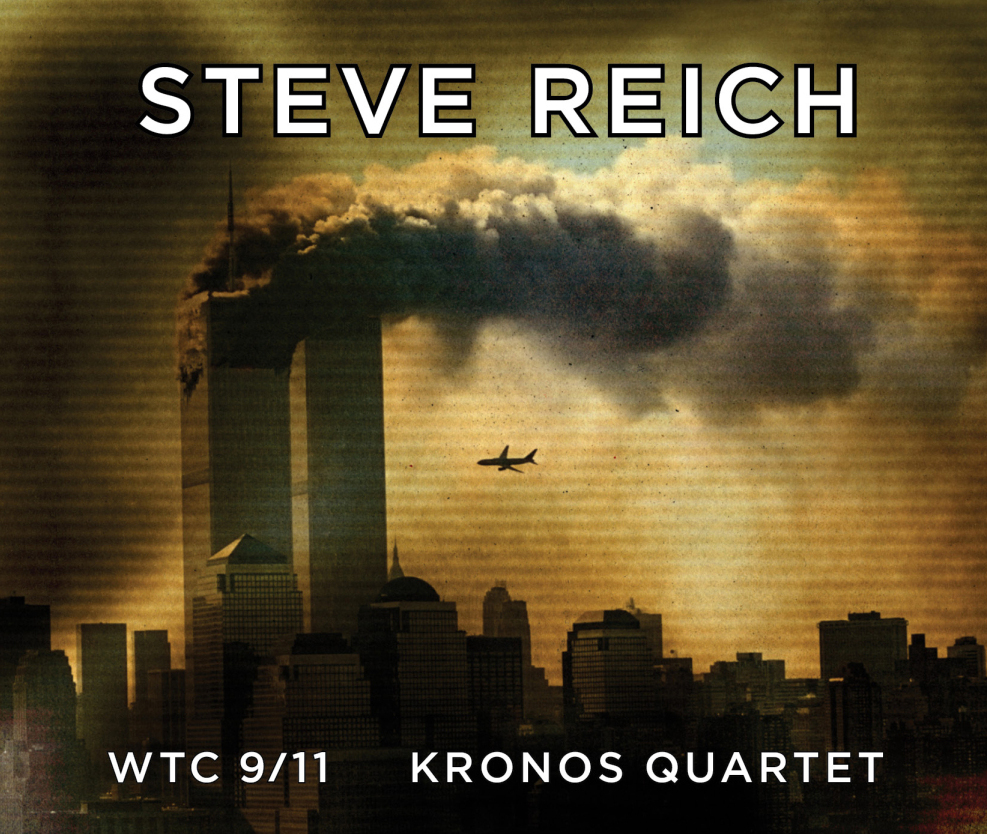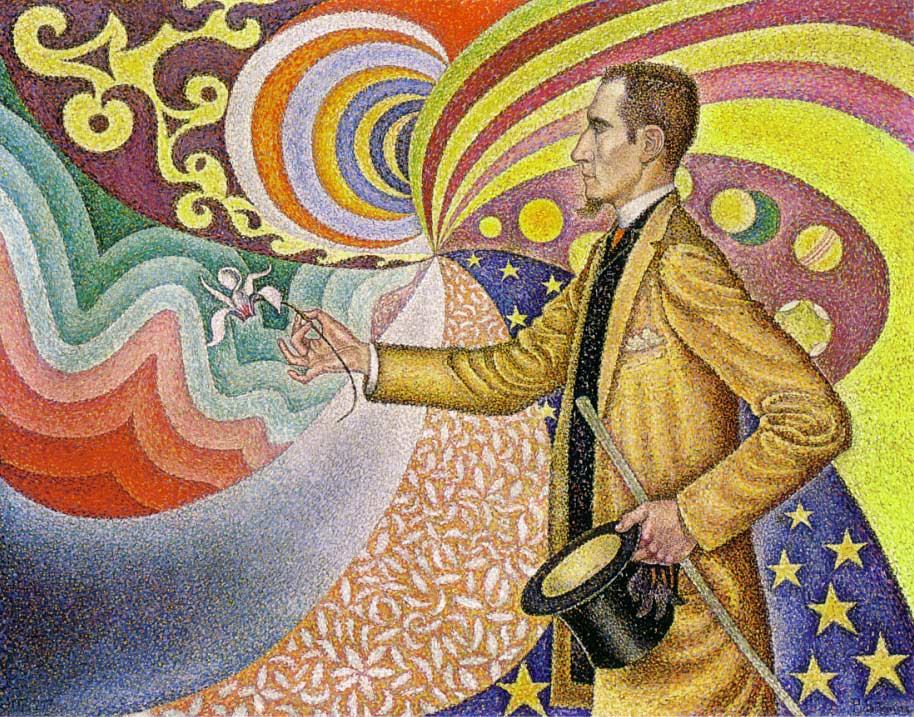Should good art always make those in positions of power and privilege feel uncomfortable, squirmy, ill at ease and irritated by pangs of consciousness even if irregular. Or is an art that is ostensibly anti banking and money serve to reinforce the mores in a hyper-capitalist society where dissent is another commodity within a larger cultural-material landscape.

---Another such painting, "Bank of America," was going for $2,750 last night. L.A. Taco notes the irony that "only people who can afford to buy his work are the same people who looted the financial system in the first place- bankers." Schaeffer, by the way, told the Times that his works were inspired by the economic apocalypse that occurred when banks invested in crap real estate loans -- by institutions "bringing the system down. Some might say that the banks are the terrorists." Read More:http://blogs.laweekly.com/informer/2011/09/bank_fire_painting_ebay.php
…A Los Angeles artist who has been making paintings that depict local branches of multinational banks on fire has caught the attention of L.A. police, according to a report in The Los Angeles Times. The artist, Alex Schaefer, was working on a painting of Chase branch in L.A. last month when police approached him and began asking questions. “They asked if I was a terrorist and was I going to follow through and do what I was painting,” Mr. Schaefer asked. Mr. Schaefer told The Times that he told the police that he did not plan to take any action against the bank, but he gave them his contact information. “The flames symbolize bringing the system down,” he said. “Some might say that the banks are the terrorists.” Last week, Mr. Schaefer says, police officers visited him at his home and asked him additional questions about his works, though they did not detain him. ….Read More:http://www.observer.com/2011/08/artists-paints-burning-banks-attracting-police-attention/

Ed Ruscha. Los Angeles County Museum on Fire. 1965-68. ---In light of this, the implication of Benjamin’s assertion that Capitalism is the dominant religion of our time is that the guilt at its centre (which is also debt, as neatly encapsulated in the German Schuld) is also the thing that bonds the community together. Not only are we a community because we are all indebted to each other, in an ironic fulfilment of the solidarity whose absence Marcel Mauss bemoaned in early Capitalism, but even those who choose not to practise Capitalism, the laymen in Durkheim’s account, still belong to the church.Benjamin writes: “religion… regarded individual who were irreligious or had other beliefs as members of its community, in the same way that the modern bourgeoisie now regards those of its members who are not gainfully employed” As we can see, Benjamin does not leave any space outside the community encircled by Capitalism and his description acknowledges the incredible flexibility and elasticity of the practise of Capitalism, redefining itself again and again to include all under the auspices of guilt and debt. This is why art practices which seek to reject the ethos of work and to withdraw completely from the cycle of consumption and production (from the art strikes of Gustav Metzger and Stuart Home to Michael Landy’s Breakdown) are tolerated or even encouraged by the art market, declining to participate does not deny you of membership. Read More:http://www.kollectiv.co.uk/Capitalism%20As%20Cult.html image:http://arttattler.com/archiveedruscha.html
So, is disconnect of community the issue. An inability to share experience or a failure to evolve relationships between the state and its institutions including the money and banking infrastructure which at its core is grounded and based on a culture that is unwilling to emancipate itself from ethno-racial centrism. Whether any movement can succeed in dismantling the money and “asset class” system is only in the realm of “the faint hope clause.”:
For Buber encounter (Begegnung) has a significance beyond co-presence and individual growth. He looked for ways in which people could engage with each other fully – to meet with themselves. The basic fact of human existence was not the individual or the collective as such, but ‘Man with Man’ (Buber 1947). As Aubrey Hodes puts it:
When a human being turns to another as another, as a particular and specific person to be addressed, and tries to communicate with him through language or silence, something takes place between them which is not found elsewhere in nature. Buber called this meeting between men the sphere of the between. (1973: 72)
… We can only grow and develop, according to Buber, once we have learned to live in relation to others, to recognize the possibilities of the space between us. The fundamental means is dialogue. ‘All real living is meeting’ he once wrote. Such meeting isn’t just between two people. Buber believed that in such encounters the eternal could be glimpsed. In speech and silence there was great possibility. In dialogue, a person is present to another (and the other), they are attentive and aware – listening and waiting. In the stillness of this ‘in-between world’ they may encounter what cannot yet be put into words.Read More:http://www.infed.org/community/community.htm
ADDENDUM:
Nelson Mandela ( Rivonia Trial, 1964):”who will deny that thirty years of my life have been spent knocking in vain, patiently, moderately, and modestly at a closed and barred door? What have been the fruits of moderation? The past thirty years have seen the greatest number of laws restricting our rights and progress, until today we have reached a stage where we have almost no rights at all”….Attacks on the economic life lines of the country were to be linked with sabotage on Government buildings and other symbols of apartheid. These attacks would serve as a source of inspiration to our people. In addition, they would provide an outlet for those people who were urging the adoption of violent methods and would enable us to give concrete proof to our followers that we had adopted a stronger line and were fighting back against Government violence….Today I am attracted by the idea of a classless society, an attraction which springs in part from Marxist reading and, in part, from my admiration of the structure and organization of early African societies in this country. The land, then the main means of production, belonged to the tribe. There were no rich or poor and there was no exploitation….

---Benjamin writes: “For the first time in world history, mechanical reproduction emancipates the work of art from its parasitical dependence on ritual.” And he continues, “Instead of being based on ritual, it begins to be based on another practice — politics.” I don’t think politics can be viewed as something separate from ritual. Politics and religion have always been linked. Also, in political narratives that legitimize power, there are invocations of “cult value” or “instruments of magic,” be it a “founding myth” of a state or nation, or in the idolization of certain historical founder figures. To me, they are two sides of the same coin. “This is the situation of politics which Fascism is rendering aesthetic. Communism responds by politicizing art.” These are the last two lines of the essay. Maybe I’m not understanding nuance here, but aren’t these the same thing? Both Fascism and Communism are mixing the art with politics or politics with art. I believe that art and politics have always been bedfellows and that the role of artists is to comment upon and engage with their societies and times. Sure, politicians and others can use art as a means of persuasion or propaganda, but others can similarly use art as a means of resistance against coercion and hegemony. ...Read More:http://leesean.net/2008/09/28/response-to-walter-benjamins-art-in-the-age-of-mechanical-reproduction/ image:http://www.halamusique.com/does-this-steve-reich-911-album-cover-cross-the-line/
…It is true, as I have already stated, that I have been influenced by Marxist thought. But this is also true of many of the leaders of the new independent States. Such widely different persons as Gandhi, Nehru, Nkrumah, and Nasser all acknowledge this fact. We all accept the need for some form of socialism to enable our people to catch up with the advanced countries of this world and to overcome their legacy of extreme poverty. But this does not mean we are Marxists….Our fight is against real, and not imaginary, hardships or, to use the language of the State Prosecutor, ‘so-called hardships’. Basically, we fight against two features which are the hallmarks of African life in South Africa and which are entrenched by legislat
which we seek to have repealed. These features are poverty and lack of human dignity, and we do not need communists or so-called ‘agitators’ to teach us about these things….Read More:http://law2.umkc.edu/faculty/projects/ftrials/mandela/mandelaspeech.htmla

Jonathan Jones:The photograph of Poussin's painting, The Adoration of the Golden Calf, sprayed with red paint, as if this precious work of art were just a wall or a bridge to be adorned with graffiti, is obscene. It is horrific. Poussin painted this mighty work in 1633-4. It is about the forces that can destroy civilisation. On their trek out of captivity in Egypt, the Israelites have raised up an idol of a golden calf and are wildly worshipping it. Poussin finds in this idol-worship an image of the seductions of wealth and glamour, the power of folly and the madness of crowds. It is a stern painting; it is a challenging painting. It is also very beautiful: the bizarre harmony of the crazed crowd's interlinked dance seems balanced in such a way as to prove that there is order in the universe after all – which means there will be retribution. Someone took a spray can to the National Gallery at the weekend and spurted a red bloody trail all over the lower half of the painting. The red line appears to rope together the dancing bodies, as if the attacker had some secret meaning in mind. Read More:http://www.guardian.co.uk/artanddesign/jonathanjonesblog/2011/jul/18/poussin-golden-calf-national-gallery-security
—————————————–
Henry Giroux:Like the angel of history in Benjamin’s rendering of Klee’s painting, the American public is surrounded by another catastrophe of history visibly invisible in the horrible suffering produced by two unnecessary wars in Iraq and Afghanistan and the current economic recession exacerbating already high levels of poverty, homelessness and joblessness now spreading like a poisonous blight across the American landscape. But unlike the forces constricting Benjamin’s angel, the storm that pins the wings of the current diminutive angel of history is more intense, more paralyzing in its hyper-materialistic visions and more privatizing in its definition of agency. The historical forces producing this storm and its accompanying catastrophes are incorrigibly blind to the emergence of a “pulverized, atomized society spattered with the debris of broken inter-human bonds and their eminently frail and breakable substitutes.” This is best exemplified in the now infamous and cruel tenets of a harsh neoliberalism stated without apology by Ronald Reagan and Margaret Thatcher in the 1980s in their mutual insistence that “government is the problem not the solution” and “there is no such thing as society.”…

felix feneon:Scratching himself with a revolver with an overly sensitive trigger, M. Edouard B. removed the tip of his nose in the Vivienne precinct house.... Nurse Elise Bachmann, whose day off was yesterday, put on a public display of insanity.... Scheid, of Dunkirk, fired three times at his wife. Since he missed every shot, he decided to aim at his mother-in-law, and connected. ...Hanging on the door, a traveler a tad overweight caused his carriage to topple, in Menilmontant, and fractured his skull.... Fire started last night in a Bastille-Montparnasse streetcar that quickly was emptied of its riders and flooded by firemen.... The corpse of a sixtyish Dorlay hung from a tree in Arcueil, with a sign reading, "Too old to work."
…Social progress has ceded the historical stage to individual actions, values, tastes and personal success, just as any notion of the common and public good that once defined the meaning of progress is rendered as pathological, the vestige of a kind of socialist nightmare that squelches any possibility of individual freedom and responsibility. If progress even in its mythic register was once associated, however flawed, with lifting the populace from the bondage of necessity, suffering and exploitation, today it has been stripped of any residual commitment to the collective good and functions largely as a kind of nostalgic relic of a historical period in American history in which a concept of the social state “was not always a term of opprobrium” or a metaphor for state terrorism. The language of progress, however false, has been replaced by the discourse and politics of austerity – which is neoliberal code for making the working and middle classes bear the burden of a financial crisis caused by hedge fund operators, banking and investment houses and the mega-rich.Read More:http://www.pubtheo.com/page.asp?pid=1608







 COMMENTS
COMMENTS



